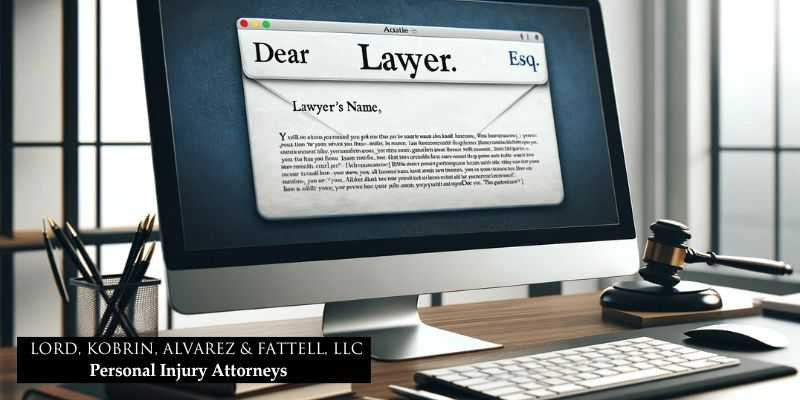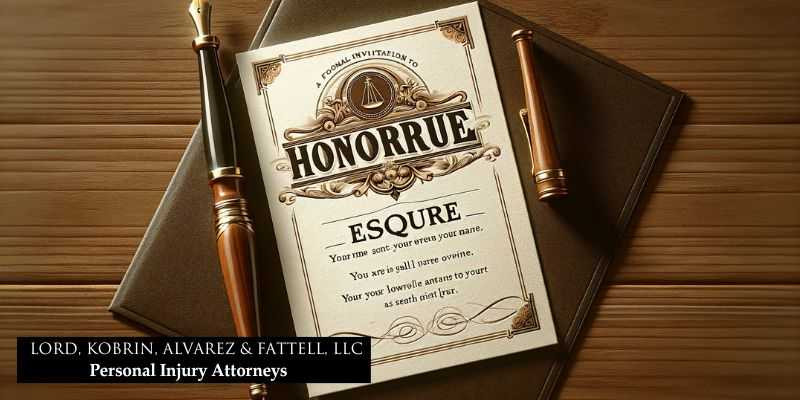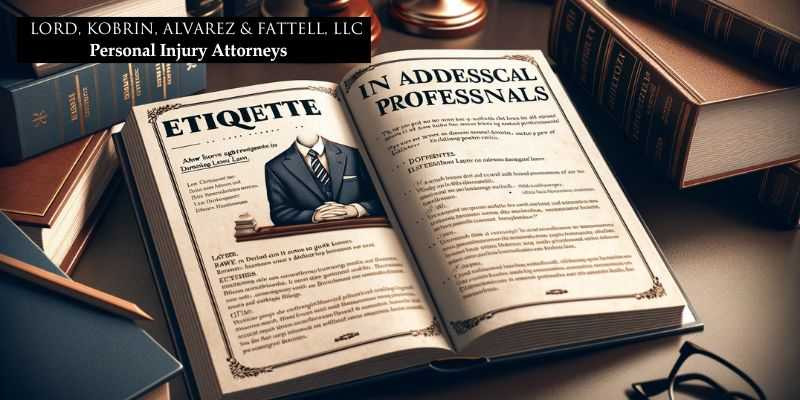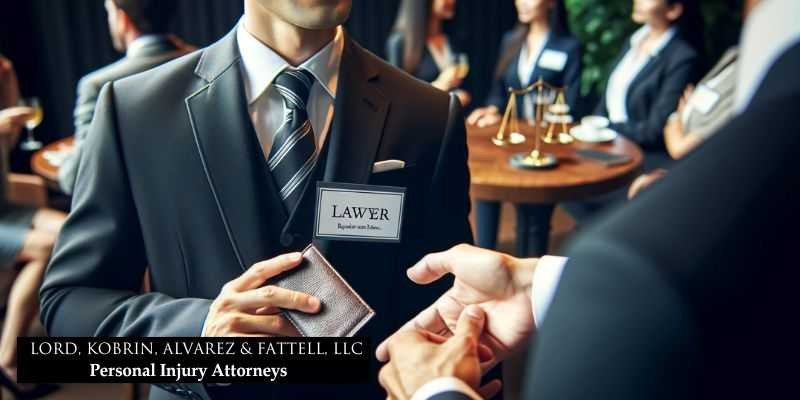Addressing a lawyer correctly in a letter is essential for establishing a respectful and professional tone. This article, brought to you by internetlawyers.net, provides clear guidelines on how to address lawyers appropriately in various situations, ensuring your communications are well-received. Learn the nuances of legal correspondence, from formal salutations to the proper use of titles, and enhance your professional interactions. Whether it’s about legal correspondence, professional etiquette, or formal communication, understanding these protocols will significantly improve your approach.
1. Understanding Professional Titles: Addressing Lawyers Formally
Professional titles, especially in the legal field, require a certain level of formality in all communications. Addressing a lawyer, also known as an ‘attorney at law,’ demands specific etiquette. Understanding this is vital, especially when corresponding or dealing with them in any formal context.
Using ‘Esq.,’ a courteous title often used as a post-nominal suffix, is a widely accepted and respectful way to address a lawyer. When writing a salutation to a lawyer, the full name followed by ‘Esq.’ is generally used. For example, you would write ‘John Doe, Esq.’ when addressing John Doe, an attorney.
However, be mindful of personal preferences when addressing female attorneys. Some might prefer ‘Ms.’ before ‘Esq.’ Always use ‘Esq.’ in a professional context and ensure the attorney’s full name precedes it. This shows respect and familiarity with proper legal decorum. According to the American Bar Association (ABA), understanding professional titles ensures effective communication and fosters a respectful relationship between clients and attorneys.
 Email addressed to a lawyer with Esq – Formal email salutation displaying the correct use of Esq in professional correspondence with a lawyer
Email addressed to a lawyer with Esq – Formal email salutation displaying the correct use of Esq in professional correspondence with a lawyer
2. The Correct Use of ‘Esquire’: When and How to Use It
When addressing an attorney socially or in informal correspondence, referring to them as ‘Esquire’ after their surname is typical, similar to using ‘M.D’ or ‘Ph.D.’ This title, often on an attorney’s business card, signifies respect and professionalism due to their bar exam success.
‘Esquire’ is traditionally associated with male legal professionals. However, when writing to an attorney with whom you have a more casual relationship, addressing them by their first name is acceptable. Regardless, the standard courtesy title, a combination of first and last name followed by ‘Esquire’ or ‘Attorney at Law,’ should be used at the beginning of the correspondence.
This applies even if the attorney holds a J.D. or a higher law degree. Using ‘Esquire’ reflects understanding and respect for professional boundaries, regardless of familiarity. According to a study by the New York State Bar Association, using the correct titles enhances professional interactions and avoids misunderstandings.
 Formal invitation card addressed to a lawyer with respectful salutation, placed on a wooden table with a fountain pen – Elegant invitation displaying the formal salutation with Esquire, demonstrating respect for the legal profession
Formal invitation card addressed to a lawyer with respectful salutation, placed on a wooden table with a fountain pen – Elegant invitation displaying the formal salutation with Esquire, demonstrating respect for the legal profession
3. Salutations in Correspondence: Mr., Ms., and Esq.
In professional correspondence, the salutation forms the foundation of every communication, setting its tone and context. Standard salutations include “Mr.,” “Ms.,” and “Esq.,” with the latter specifically for those in law.
Using “Dear Mr./Ms. [Last Name]” followed by a comma is suitable when establishing a new professional relationship. When addressing a practicing female attorney, additional considerations are necessary.
Many married female attorneys may prefer using their maiden name, especially if they established their professional reputation before marriage. Respecting this choice is crucial in legal matters. In more casual settings, they might use their married name socially.
For addressing a lawyer and their spouse, use “Ms. [Maiden Name] and Mr. [Spouse’s Last Name].” This respects the attorney’s professional identity without compromising social norms. Research from the American Association for Justice highlights the importance of personalized salutations in fostering positive client-attorney relationships.
4. Professional vs. Social Address: Navigating Formal and Casual Settings
Understanding how to address a legal practitioner varies significantly based on the setting—professional versus social. If an attorney has multiple titles, use the one they typically use professionally, such as ‘Esquire’ or academic credentials.
In court or business correspondence, use full formal titles or initials, indicating their qualifications. ‘Esquire,’ often ‘Esq.,’ is used after the licensed attorney’s full name in the U.S.
In social settings, a more relaxed tone is acceptable. If you know the attorney well, use courtesy titles like Mr., Ms., or Mrs. with their surname. Asking about their preferred title shows respect.
Using a standard courtesy title recognizes their professional credentials while balancing friendliness and respect. A survey by the National Association of Legal Professionals indicates that attorneys appreciate acknowledgment of their professional status in both formal and informal settings.
 Book titled
Book titled
5. Addressing Female Attorneys: Navigating Titles and Names
In legal circles, knowing how to address female attorneys, especially those using their maiden name professionally, is crucial. Adherence to professional etiquette is essential for those who have graduated from law school and earned legal titles.
A common misconception is that female attorneys should be addressed differently than male attorneys. However, regardless of gender, an attorney’s first and last name should always be used in professional communication, emphasizing mutual respect.
When mailing a letter or official correspondence, write the attorney’s full name. Some female attorneys may use their spouse’s name socially but list their maiden name professionally.
Titles like “esquire” or “esq.” typically follow the attorney’s name, showing respect and following proper protocol in legal and formal communications. Some may prefer their academic credentials like ‘JD’ or ‘LLB’ following their name, highlighting the importance of context and personal preference. Research by the National Federation of Paralegal Associations shows that respecting professional titles increases trust and credibility in legal interactions.
6. ‘Attorney at Law’ and Other Formal Designations
The designation ‘Attorney at Law’ traditionally indicates an individual is licensed to practice law. This title reflects their rigorous education and the privileges and responsibilities of passing the state bar exam.
This recognition signifies that they are equipped to provide legal aid professionally. Some attorneys prefer being recognized by their first and last names without formal designations.
Addressing an attorney according to their preference shows appreciation and acknowledges an ongoing professional relationship. In professional settings, especially when the spouse is a doctor or has another distinctive accolade, respect the spouse’s title similarly.
Socially, address the couple as ‘Dr. and Mr./Ms./Mrs.’ if their spouse is a doctor. Different countries may have different customs for addressing professionals and their spouses. In formal letters, avoid salutations like ‘Dear Mr.’ and instead use ‘Esq.’ or ‘Attorney’ before the receiver’s name.
Always align with the highest to lowest order of professional designations to show honor and respect. Maintaining appropriate title protocol recognizes individuals’ professional achievements. According to the ABA, correct use of professional titles promotes a culture of respect and professionalism in the legal community.
 Person and lawyer exchanging business cards at a networking event, highlighting respectful address in a social setting – Networking event showing the exchange of business cards, emphasizing respectful address and professional interaction between a person and a lawyer
Person and lawyer exchanging business cards at a networking event, highlighting respectful address in a social setting – Networking event showing the exchange of business cards, emphasizing respectful address and professional interaction between a person and a lawyer
7. Academic Credentials and Legal Titles: JD and Beyond
In academic credentials, the juris doctorate, or JD, represents a significant achievement in law. This degree typically means someone has completed three years of law school and can practice law professionally.
Unlike doctors or Ph.D. holders, using their academic title in social situations is not common for JD holders. This is a recognized norm within the legal profession, reflecting unspoken etiquette.
When addressing these individuals, accurately ordering their names and titles is crucial. Professionally, ‘Esquire,’ often abbreviated as ‘Esq.,’ follows the full name as a sign of respect.
Socially, ‘Mr.’ or ‘Ms.’ commonly precedes their names. Usage largely depends on the circumstance, underscoring the importance of understanding professional and social contexts.
Using titles appropriately shows respect and acknowledges their years of hard work. Research from the Law School Admission Council (LSAC) indicates that respecting academic achievements fosters a positive and professional environment within the legal field.
8. Common Mistakes to Avoid When Addressing a Lawyer
Addressing a lawyer requires attention to detail to avoid common errors that could undermine your communication. Here are some mistakes to steer clear of:
- Using the Wrong Title: Avoid using “Doctor” unless the lawyer also holds a doctoral degree. Stick to “Mr.,” “Ms.,” or “Esq.”
- Misspelling Names: Always double-check the spelling of the lawyer’s name. A misspelled name can be seen as careless and disrespectful.
- Incorrectly Using “Esq.”: The term “Esq.” should only be used for attorneys who are licensed to practice law. It is placed after the attorney’s full name.
- Mixing Social and Professional Contexts: Avoid using informal language or nicknames in professional correspondence. Maintain a formal tone.
- Ignoring Personal Preferences: If you are aware that a lawyer prefers a certain title or name, respect their preference.
- Forgetting to Update Information: Ensure your contact list is current. Lawyers may change firms or titles over time.
- Assuming Gender: When unsure, research the lawyer’s gender to use the correct pronoun and title.
- Using Only First Names: Unless you have a close, informal relationship with the lawyer, always use their title and last name.
- Addressing as “Dear Sir/Madam”: This generic salutation is outdated. Always try to address the lawyer by their name.
- Omitting Titles in Formal Documents: In legal documents, always include the appropriate title to ensure the document is considered valid and respectful.
Avoiding these mistakes ensures your communication is professional, respectful, and effective. According to a survey by the International Association of Legal Professionals, attention to detail in communication significantly impacts a lawyer’s perception of your professionalism.
9. Step-by-Step Guide to Addressing a Lawyer in a Letter
To ensure you address a lawyer correctly in a letter, follow these step-by-step guidelines:
- Research the Lawyer:
- Find the lawyer’s full name, title, and preferred form of address.
- Check their firm’s website or professional profiles for accurate information.
- Choose the Correct Salutation:
- Use “Dear Mr. [Last Name]” or “Dear Ms. [Last Name]” if you’re unsure of their preference.
- Use “Dear [First Name]” only if you have a close, informal relationship.
- For a more formal approach, use “Dear [Full Name], Esq.”
- Address the Envelope:
- Write the lawyer’s full name on the first line.
- Include their professional title (e.g., Attorney at Law) if appropriate.
- Add the name of the law firm on the next line.
- Provide the full address, including street, city, state, and ZIP code.
- Maintain a Professional Tone:
- Use formal language throughout the letter.
- Avoid slang, colloquialisms, and overly familiar expressions.
- Be respectful and courteous in your writing.
- Use Proper Formatting:
- Ensure the letter is well-structured with clear paragraphs.
- Use a professional font and paper.
- Proofread carefully for any errors in grammar or spelling.
- Consider Cultural Differences:
- Be aware of any cultural norms that may influence how professionals are addressed.
- In some cultures, formality is highly valued, while in others, a more relaxed approach is acceptable.
- Follow Up If Necessary:
- If you’re unsure about the correct way to address the lawyer, don’t hesitate to call the firm and ask.
- It’s better to clarify than to make a mistake that could be perceived as disrespectful.
- Example of a Properly Addressed Envelope:
[Full Name], Esq.
Attorney at Law
[Law Firm Name]
[Street Address]
[City, State, ZIP Code]Following these steps ensures that your letter is well-received and conveys the respect and professionalism that the legal field demands. According to a guide by the American Bar Association, proper etiquette in written communication enhances your credibility and strengthens professional relationships.
10. Resources for Further Information on Legal Etiquette
For those seeking more in-depth knowledge on legal etiquette, several resources are available:
- The American Bar Association (ABA): The ABA offers guidelines and publications on legal professionalism and ethics. Visit their website for valuable insights.
- State Bar Associations: Each state has its own bar association, which provides resources on local legal practices and etiquette. Check your state’s bar association website for specific information.
- Law School Libraries: Law school libraries often have extensive collections of books and articles on legal writing, communication, and professional conduct.
- Legal Journals and Publications: Journals such as the “American Law Journal” and the “National Law Review” frequently cover topics related to legal ethics and etiquette.
- Professional Legal Organizations: Organizations like the National Association of Legal Professionals (NALS) offer courses and certifications in legal office procedures and etiquette.
- Online Legal Forums: Platforms like Avvo and FindLaw provide forums where legal professionals discuss best practices and etiquette tips.
- Books on Legal Writing and Communication: Numerous books focus on effective legal writing and communication skills. Look for titles that address professional etiquette.
- Continuing Legal Education (CLE) Courses: Many CLE providers offer courses on legal ethics, communication, and professionalism.
These resources provide a wealth of information to help you navigate the nuances of legal etiquette and ensure your interactions with lawyers are professional and respectful. According to research from the Legal Writing Institute, continuous learning and staying informed about best practices are essential for maintaining a high standard of professionalism in the legal field.
FAQ: Addressing Lawyers in Letters
- Question 1: What is the correct way to address a lawyer in a formal letter?
The correct way is to use “Dear Mr. [Last Name], Esq.” or “Dear Ms. [Last Name], Esq.” if you know they are licensed to practice law. - Question 2: Can I use “Attorney at Law” in the address?
Yes, you can use “Attorney at Law” after their full name on the envelope, but “Esq.” is more common in the salutation. - Question 3: What if I don’t know the lawyer’s gender?
If unsure, use their full name and “Esq.” or call their office to ask for their preferred form of address. - Question 4: Is it okay to use “Dear Sir/Madam” in a letter to a lawyer?
No, it’s best to avoid generic salutations. Always address the lawyer by name. - Question 5: Should I use “Mr.” or “Ms.” if the lawyer is also a judge?
Use “The Honorable” followed by their full name if they are a judge. - Question 6: How do I address a letter to a law firm?
Address the letter to the specific lawyer handling your case, not just the firm. - Question 7: Is it necessary to include academic titles like “JD” in the address?
No, academic titles are generally not included in the address or salutation. - Question 8: What if the lawyer has multiple advanced degrees?
Focus on their legal title (Esq.) rather than other academic degrees. - Question 9: How should I address a female lawyer who uses her maiden name professionally?
Use her maiden name followed by “Esq.” in professional correspondence. - Question 10: What is the etiquette for addressing a lawyer in an email?
Follow the same guidelines as for a formal letter: use a professional salutation and title.
Navigating the intricacies of addressing lawyers in letters can be straightforward with the right guidance. Internetlawyers.net is your go-to resource for reliable legal information and access to qualified attorneys. Whether you’re dealing with a complex legal issue or simply need advice, our platform connects you with experienced professionals who can help.
Don’t let uncertainty hold you back. Visit internetlawyers.net today to find the legal support you need.
